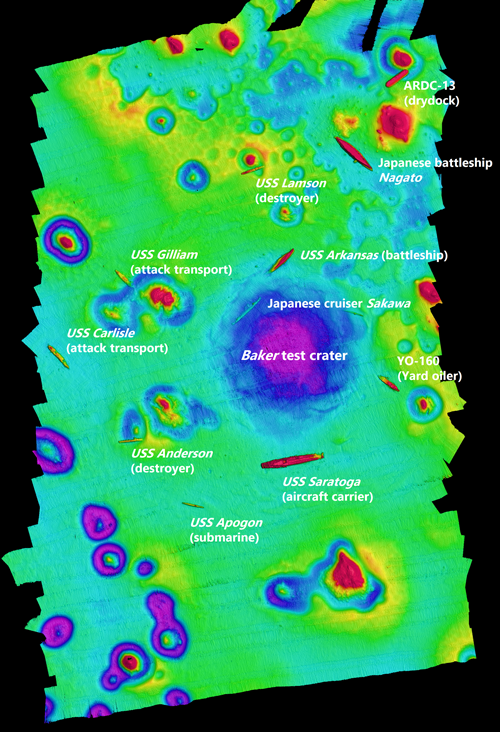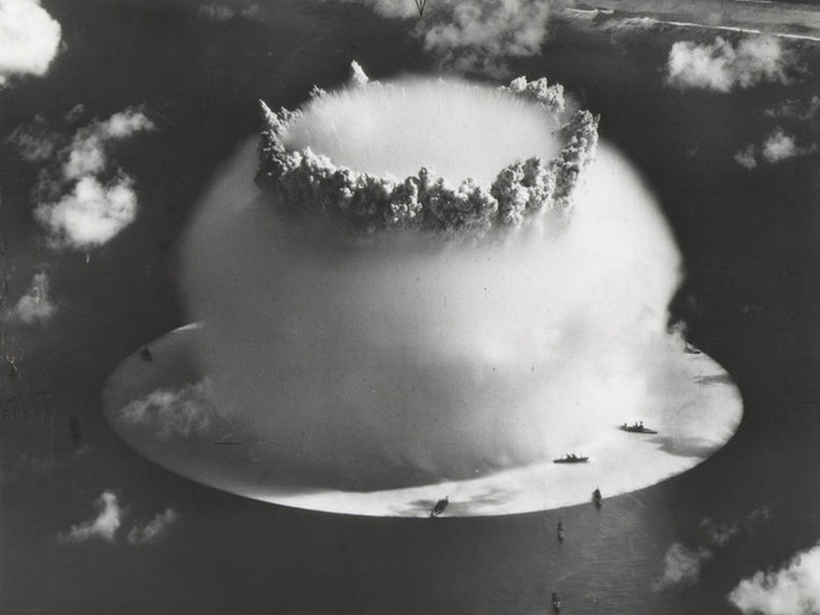From 1946 to 1958, the U.S. military conducted more than 20 nuclear bomb tests at Bikini Atoll, an idyllic tropical island in the South Pacific Ocean. During the first of these tests, conducted in July 1946, the military anchored nearly 100 warships and submarines within Bikini’s large lagoon to see how a nuclear blast would affect a naval fleet.
The first bomb, in test Able, was detonated in the air and caused a less than expected amount of damage to the fleet. The second bomb, in test Baker, was suspended below a barge and detonated underwater.
Glenn Seaborg, former chairman of the Atomic Energy Commission, called it “the world’s first nuclear disaster.”
Baker was far more destructive than the military had planned. It was the first nuclear bomb ever detonated underwater, and chemist Glenn Seaborg, former chairman of the Atomic Energy Commission, called it “the world’s first nuclear disaster.”
The Baker detonation left a crater on the seafloor roughly 800 meters (half a mile) wide and 10 meters (33 feet) deep. The underwater fireball created a supersonic shock wave that expanded outward and crushed the hulls of the closest ships. A colossal column of boiling, radioactive water then poured over the array of target ships, tossing them about like toys in a bathtub.
Three major ships and several small aircraft were sunk within the first few days. The remainder of the fleet was so contaminated with radiation that only 9 of Baker’s original 84 ships were able to be scrapped—the rest were deliberately sunk.
No remnant of the barge from which the bomb was suspended has ever been found. The Baker test was so different from every other detonation that researchers held a conference 2 months later to define all the new phenomena observed in the explosion.

The original inhabitants of Bikini were evacuated prior to the tests, but the island was so contaminated by radioactivity from the blasts and pollutants released by the sunken ships that they have never been able to return.
University of Delaware professor Art Trembanis spent the summer of 2019 mapping the seafloor around Bikini to see if he could find evidence of the tests all these decades later.
Art and his colleagues have so far discovered the craters from Baker and other tests have left permanent scars on the seafloor around the atoll. The wrecks of sunken ships are still visible and still leaking fuel into the surrounding water, and it is unlikely anyone will be able to inhabit Bikini in the near future.
In the latest episode of AGU’s podcast Third Pod from the Sun, Art tells the story of the Baker test and describes his experience diving through the lagoon’s many shipwrecks. He recounts the mesmerizing sequence of events triggered by the Baker detonation and explains how a tropical paradise became a battleship graveyard.
—Lauren Lipuma (@Tenacious_She), Program Manager, Media Relations, AGU
Citation:
Lipuma, L. (2020), Podcast: Paradise lost, Eos, 101, https://doi.org/10.1029/2020EO142399. Published on 06 April 2020.
Text © 2020. AGU. CC BY-NC-ND 3.0
Except where otherwise noted, images are subject to copyright. Any reuse without express permission from the copyright owner is prohibited.

